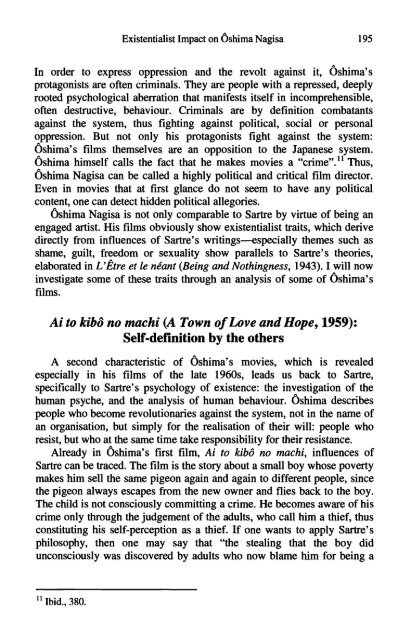Sartre's second century
Sartre's second century
Sartre's second century
Create successful ePaper yourself
Turn your PDF publications into a flip-book with our unique Google optimized e-Paper software.
Existentialist Impact on 6shima Nagisa 195<br />
In order to express oppression and the revolt against it, Oshima's<br />
protagonists are often criminals. They are people with a repressed, deeply<br />
rooted psychological aberration that manifests itself in incomprehensible,<br />
often destructive, behaviour. Criminals are by definition combatants<br />
against the system, thus fighting against political, social or personal<br />
oppression. But not only his protagonists fight against the system:<br />
Oshima's films themselves are an opposition to the Japanese system.<br />
Oshima himself calls the fact that he makes movies a "crime". 11 Thus,<br />
Oshima Nagisa can be called a highly political and critical film director.<br />
Even in movies that at first glance do not seem to have any political<br />
content, one can detect hidden political allegories.<br />
Oshima Nagisa is not only comparable to Sartre by virtue of being an<br />
engaged artist. His films obviously show existentialist traits, which derive<br />
directly from influences of <strong>Sartre's</strong> writings—especially themes such as<br />
shame, guilt, freedom or sexuality show parallels to <strong>Sartre's</strong> theories,<br />
elaborated in u£tre et le neant {Being and Nothingness, 1943). I will now<br />
investigate some of these traits through an analysis of some of Oshima's<br />
films.<br />
Ai to kibo no machi (A Town of Love and Hope, 1959):<br />
Self-definition by the others<br />
A <strong>second</strong> characteristic of Oshima's movies, which is revealed<br />
especially in his films of the late 1960s, leads us back to Sartre,<br />
specifically to <strong>Sartre's</strong> psychology of existence: the investigation of the<br />
human psyche, and the analysis of human behaviour. Oshima describes<br />
people who become revolutionaries against the system, not in the name of<br />
an organisation, but simply for the realisation of their will: people who<br />
resist, but who at the same time take responsibility for their resistance.<br />
Already in Oshima's first film, Ai to kibo no machi, influences of<br />
Sartre can be traced. The film is the story about a small boy whose poverty<br />
makes him sell the same pigeon again and again to different people, since<br />
the pigeon always escapes from the new owner and flies back to the boy.<br />
The child is not consciously committing a crime. He becomes aware of his<br />
crime only through the judgement of the adults, who call him a thief, thus<br />
constituting his self-perception as a thief. If one wants to apply <strong>Sartre's</strong><br />
philosophy, then one may say that "the stealing that the boy did<br />
unconsciously was discovered by adults who now blame him for being a<br />
11 Ibid., 380.
















